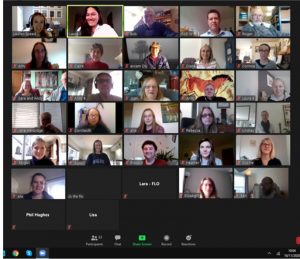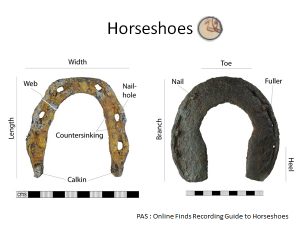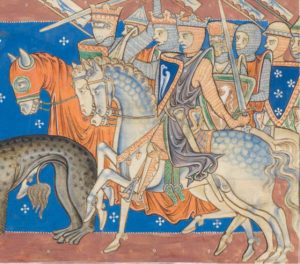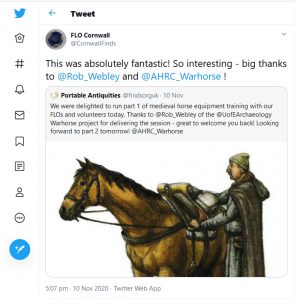Earlier this month the ‘Warhorse’ team ran a training event for our project partner the Portable Antiquities Scheme (PAS) about the medieval equestrian metal objects that could be brought to them for recording. It was a session of its Covid-19 time, delivered successfully by Zoom to over thirty participants, PAS staff and volunteers alike.
Every year, staff at the Portable Antiquities Scheme (PAS) are brought hundreds of small metal artefacts found by members of the public that formed parts of medieval horse equipment and decoration. The Warhorse team had lined up a training session for our project partner to consider this equipment, put it into context and discuss how best to record it, but it soon became apparent that we could not deliver it in person. With the welcome assistance of PAS staff, however, Rob Webley (Warhorse) and Laura Jones (University of Exeter) were able to offer this material culture training virtually in early November. It ended up being very popular, with over thirty attendees — more than if it had been run in person!

Screenshot of participants attending the material culture training session run by the Warhorse project in November 2020
The session was in fact run across two days — 10th and 11th November — to make it as accessible and digestible as possible. Content was split, with the first morning more introductory and contextual and the second tailored to the identification of material and its recording on the Portable Antiquities Scheme’s database. In part one different sources were examined to gain a sense of the types of medieval material that might be encountered and to also think through what might not have survived. There was also a special section on heraldry, which is particularly pertinent as many non-ferrous items of equestrian equipment have ‘heraldic’ decoration and also because it can be an obscure subject for the novice due to the technical language involved. It seems that such contextualisation was appreciated, with one participant commenting how good it was to see:
“PAS material put into the wider context of excavated material and documentary sources”
Detail from the Trinity College Apocalypse, Cambridge MS R.16.2, f. 23 © Masters and Fellows of Trinity College, Cambridge, reproduced under a Creative Commons Attribution-Non-commercial 4.0 license
On the second morning, our training session turned to the tailored PAS work of recognising, classifying and recording horse-related artefacts. Extended sections covered horseshoes, stirrups, bridle bits and spurs. If you are interested, further information about how the PAS records these items is provided in their online Finds Recording Guides, some of which were written by the Warhorse team. It was encouraging to see from the feedback that attendees could see that enriching the PAS data helped facilitate novel research into the material.

Screenshot of training slide detailing horseshoe terminology
With so much of 2020 about having to make the most of tricky and ever-changing circumstances, we were grateful that our training reached so many PAS staff members and volunteers, and we would like to thank the PAS for organising it. The format actually allowed for a different sort of engagement, including through the chat function and other, verbal question-and-answer sessions. Whether a re-run will be in person or online remains to be seen but we look forward to engaging more attendees with both the artefacts and the Warhorse project. As one of the participants commented:
“I had a look at the [Warhorse] website and found it extremely interesting. I’m looking forward to keeping up with some of the blogs. It sounds like a great collaboration for PAS.”
Screenshot of tweet by FLO Cornwall following the training


